[wptabs mode=”vertical”]
[wptabtitle] Hardware Specifications [/wptabtitle]
[wptabcontent]
The Kinect provides convenient access to a stack of hardware sensors that are capable of working in sync with each other at an affordable price tag. A general overview on each of the sensors is given here when available.
Power Consumption: 2.25W
Field of View for Both Cameras:
Horizontal field of view: 57 degrees
Vertical field of view: 43 degrees
Tilt Motor Range: -27 to 27 degrees vertical (from base)
Connection Interface: The Kinect port is a Microsoft proprietary connector that provides power and data communication for the Kinect sensor. Ideally Microsoft would have used a USB port, but due to the additional load of the pivot motor, a standard Xbox 360 USB port could not provide enough power for this device. All of the newer Xbox 360 slim models include a dedicated Kinect port.
If you own an older Xbox 360 console you will need a spare USB port and an external power supply. This power supply is provided with the Kinect pack as standard.
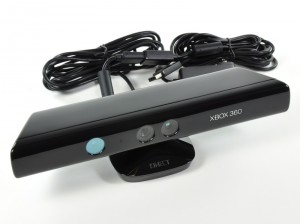
“Microsoft Kinect Teardown.” iFixit, n.d. http://www.ifixit.com/Teardown/Microsoft-Kinect-Teardown/4066/1.
[/wptabcontent]
[wptabtitle] Camera(RGB) Specifications[/wptabtitle]
[wptabcontent]
The Kinect camera is an RGB device with a resolution of 640×480 and a 24 bit color range (Red- Green- Blue channels).
Working at a rate of 30 frame captures per second this camera, this camera is similar to the run of the mill webcam or the sensors in your digital camera and it is, in most regards, very commonplace.
The camera is capable of capturing 1280×960 resolution however it seems that the fastest frames per second (fps) achievable at this higher definition is about 15fps. Conversely faster frame rates are possible by setting the resolution of the camera lower.
The Kinect sensor is limited in the distance that it can see and has a working range of between 1.2 and 3.5 meters. The horizontal field of view is 57° wide, which means at its maximum range it will be able to scan a scene 3.8 meters wide.
The sensor has a vertical field of view of 43° or 63 cm (25 in). This field of view is enhanced by the vertical pivot system that allows the sensor to be tilted up or down by as much as 27° in either direction.
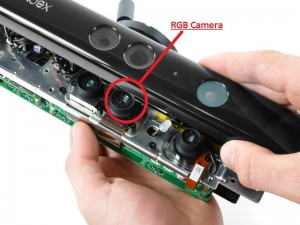
“Microsoft Kinect Teardown.” iFixit, n.d. http://www.ifixit.com/Teardown/Microsoft-Kinect-Teardown/4066/1.
[/wptabcontent]
[wptabtitle] IR Depth Sensor Specifications [/wptabtitle]
[wptabcontent]
An infrared (IR) emitter and an IR depth sensor give the Kinect its depth measuring capabilities. The emitter emits infrared light beams and the depth sensor reads the IR beams reflected back to the sensor. The reflected beams are converted into depth information measuring the distance between an object and the sensor. This makes capturing a depth image possible.
The depth sensor system consists of an infrared projector and a monochrome CMOS sensor. Located to either side of the RGB camera, the depth sensor has a resolution of 640×480 with 16 bit sensitivity. ***Note that some sources say the depth feed is actually 11-bits.
This means it can see roughly 65,000 shades of grey. Like the RGB camera, the depth sensor also captures video at a rate of 30 frames per second. However depending on the machine you are running it on, complexity of the task being done, etc. dropping frames seems to be a common mishap.
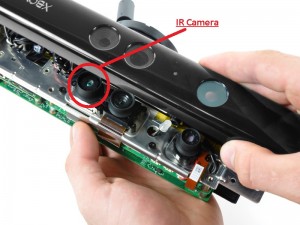
“Microsoft Kinect Teardown.” iFixit, n.d. http://www.ifixit.com/Teardown/Microsoft-Kinect-Teardown/4066/1.
Some rough estimates of the accuracy of the depth sensor:
- Range: ~ 50 cm to 5 m. Can get closer (~ 40 cm) in parts, but can’t have the full view be < 50 cm.
- Horizontal Resolution: 640 x 480 and 45 degrees vertical Field of View (FOV) and 58 degrees horizontal FOV. Simple geometry shows this equates to about ~ 0.75 mm per pixel x by y at 50 cm, and ~ 3 mm per pixel x by y at 2 m.
- Depth resolution: ~ 1.5 mm at 50 cm. About 5 cm at 5 m.
- Noise: About +-1 DN at all depths, but DN to depth is non-linear. This means +-1 mm close, and +- 5 cm far.
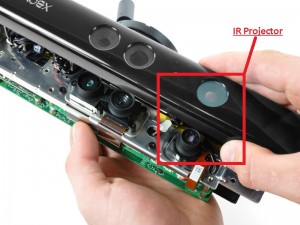
“Microsoft Kinect Teardown.” iFixit, n.d. http://www.ifixit.com/Teardown/Microsoft-Kinect-Teardown/4066/1.
Here are some useful papers reviewing the specifications of the depth image:
Khoshelham, K. and Oude Elberink, S.J. (2012) Accuracy and resolution of Kinect depth data for indoor mapping applications. In: Sensors : journal on the science and technology of sensors and biosensors : open access, 12 (2012)2 pp. 1437-1454.
Nathan Crock has also developed his own accuracy testing for the Kinect which can be viewed here: http://mathnathan.com/2011/02/03/depthvsdistance/
The ISPRS Laser Scanning Proceedings: http://www.isprs.org/proceedings/XXXVIII/5-W12/info.pdf
[/wptabcontent]
[wptabtitle] Microphone Array Specifications [/wptabtitle]
[wptabcontent]
The Kinect microphone is capable of localizing acoustic sources and suppressing ambient noise. This allows people to chat over Xbox Live without a headset.
Physically the microphone consists of an array of 4 microphone capsules. Each of the four channels processes sound at in 16 bit audio at a rate of 16 KHz.
This is an array of four microphones that can isolate the voices of the players from the noise in the room. This allows the player to be a few feet away from the microphone and still use voice controls.
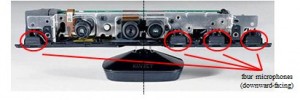
“Microsoft Kinect Teardown.” iFixit, n.d. http://www.ifixit.com/Teardown/Microsoft-Kinect-Teardown/4066/1.
[/wptabcontent]
[/wptabs]
Power Consumption: 2.25W
Field of View for Both Cameras:
Horizontal field of view: 57 degrees
Vertical field of view: 43 degrees
Tilt Motor Range: -27 to 27 degrees vertical (from base)